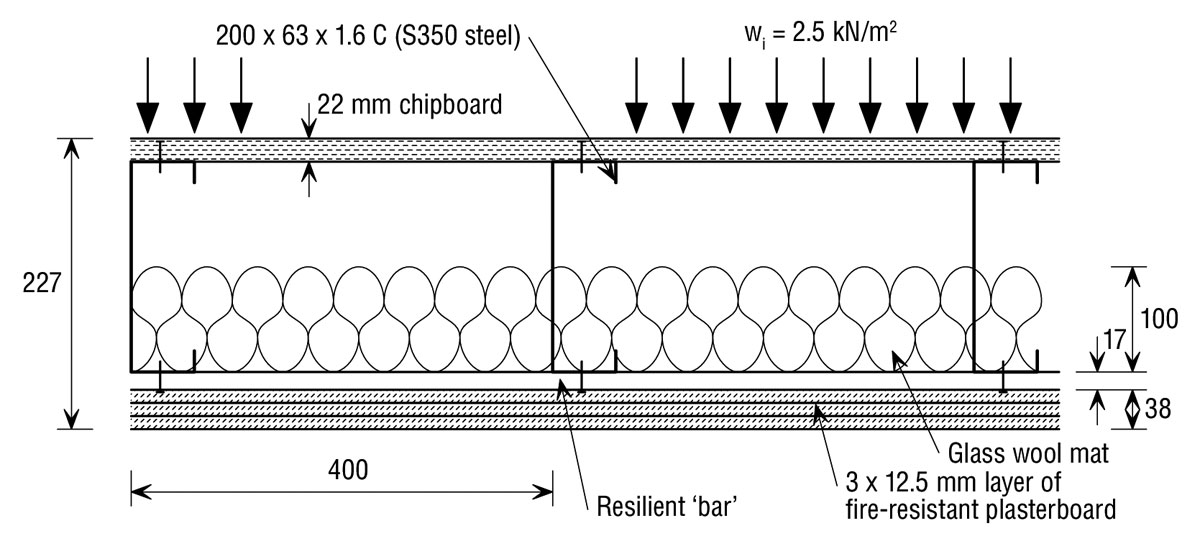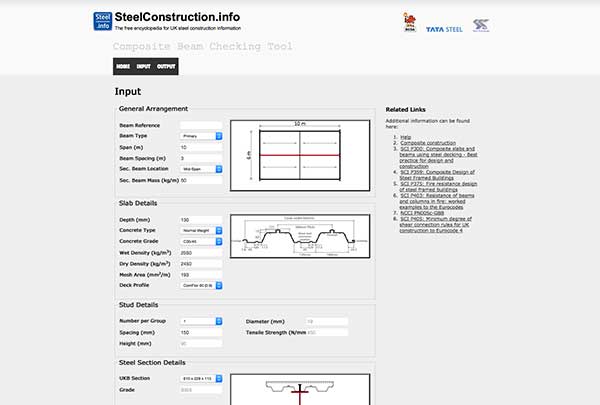Technical
Successful fire test on light steel floor
The Steel Construction Institute carried out the first industry sponsored fire test on a light steel floor that achieved 90 minutes fire resistance to the BS EN 1365 fire test. The work was sponsored by Corus Strip and members of the Light Steel Framing Group. Mark Lawson, SCI Professor of Construction Systems at the University of Surrey writes.
Light steel load bearing frames are widely used in buildings of up to eight storeys, for which fire resistance periods of 60 and 90 minutes are mainly required: the former for buildings of up to five to six storeys. It is important that the light steel and modular industries have economic solutions for load-bearing floors and walls to achieve fire and acoustic requirements to meet new Regulations and modern design and test standards.
The introduction of the BS EN 1365 fire test regime requires an extensive programme of re-testing, as it is more severe than the former BS 476- 20 test due to the use of plate thermocouples. This is particularly important as wall and floor configurations that just achieved a given fire resistance rating may now not do so. Furthermore, the advent of Eurocode 3-1 will mean that design and test standards are linked and not covered by ‘deemed to satisfy’ provisions that were historically accepted by Regulations in the UK.
Recent fire tests on load bearing light steel walls show that 2 × 15 mm fire resistant boards fixed to resilient bars are necessary to achieve 90 minutes fire resistance. For floors, the fire performance is more sensitive to the particular details and boards used because in fire, there is a tendency for the boards to bow or break away under their own weight. Furthermore, the load ratio acting on the joists is another variable, given that floor joists are generally not loaded to their full capacity when designed for control of deflections and vibrations.
In 1993, SCI had commissioned two generic fire tests on light steel floors which achieved 30 and 60 minutes fire resistance with single or double layers of 12 mm fire resistant plasterboard. This was fundamental in the preparation of SCI Publication 129: Fire resistance of cold formed steel sections, which is being updated currently. Importantly for the light steel and modular industries, no fire test on lightweight flooring using C section joists with plasterboard had achieved 90 minutes to the new BS EN standard.
As part of the Light steel and Modular Framing Group activities, an industry sponsored fire test to BS EN 1365 was carried out at the Building Research Establishment on 4th March with a target of 90 minutes fire resistance in order to provide generic guidance for the light steel framing industry. The configuration of the light steel floor also satisfies the proposed Robust Standard Detail for acoustic performance in order that the information is widely applicable to practice.
Details of the floor fire test
The agreed parameters of the fire test to BS EN 1365 were:
- Floor of 4.5 m span × 3.5 m width to fit in the BRE Test furnace
- Imposed loading to 2.5 kN/m² plus self weight for residential or light commercial applications
- C section joists – 200 mm deep × 63mm flange x 1.6 mm thick C – placed at 400 mm centres.
- Three layers of 12.5 mm fire resistant plasterboard to Type F BS EN 520 that was screw fixed to acoustically resilient bars placed at 400 mm centres along the joists.
- 100mm thick glass-wool placed between the joists, primarily required for acoustic insulation.
- chip-board screw fixed to the top flange (in practice an acoustically built-up floor is necessary, but this makes little difference to the performance of the floor in fire).
The calculated load ratio for the floors joists in the tests was 0.3 (using S 350 steel) to BS 5950-8, based on acceptable serviceability design for this floor span and loading. Using this load ratio, the test results may be extended to other joists sizes, loads and spans. The cross section through the test floor is shown in Figure 1.
Fire test results

Figure 2: View of the light steel floor under a load of 250 kg/m² at the end of the 90 minutes fire resistance test at BRE
The fire test at the Building Research Establishment supported the applied load for 93 minutes, although the designated failure of the test was at 92 minutes in terms of the integrity criterion. Importantly, for the steel joists, their temperature remained at less than 100°C for over 80 minutes and so the joists would be essentially undamaged and re-usable, even after a severe fire. At 90 minutes, the joist temperature reached 280°C, at which point the furnace temperature was over 1000°C. The mean temperature of the upper surface was less than 60°C, which was well within the 140°C limit for the BS EN test.
During the first 80 minutes of the test, the increased deflection of the floor was less than 5mm, in addition to a 9mm static deflection when the 250 kg/m² imposed load was applied initially. Even at 90 minutes, the deflection had only reached 30mm, which was well below the span/30 limit of 140mm to the fire test standard. At the eventual failure at 93 minutes, the deflection was 230mm due to the rapidly increasing steel temperature, which had reached approximately 400°C at this stage. This critical temperature correlates with the load ratio of 0.3 or a strength retention of 30% for the cold formed steel sections to BS 5950-8. The floor after testing and still under load is shown in Figure 2.
The information from this test will be used in the update of SCI publication 129: Fire Resistance of Cold Formed Steel Members, and can be used immediately by the light steel manufacturers to support their multi-storey design project work and development strategies.
The sponsors of the fire test were: Corus Strip, Ayrshire Metal, Fusion Building Systems, Metek Building Systems, Metsec, Kingspan Off-site and Lafarge Plasterboard.













